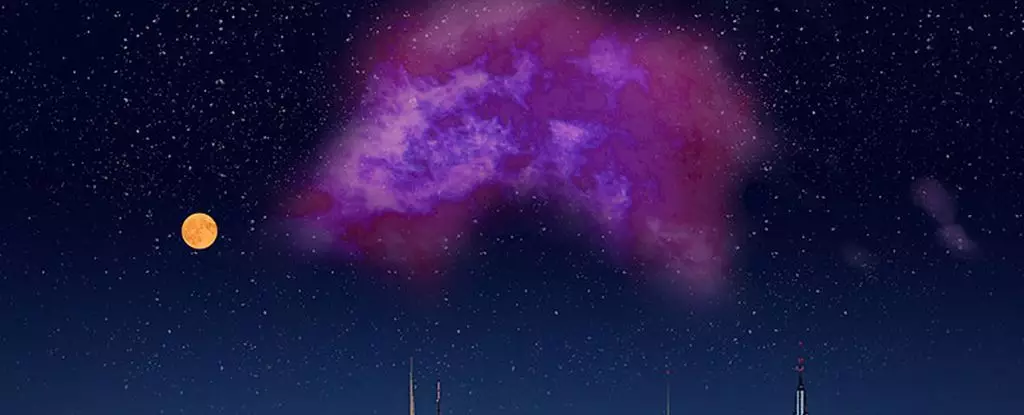On the cosmic canvas of our universe, a monumental breakthrough has emerged from the depths of interstellar darkness. Researchers have unveiled a substantial cloud of molecular hydrogen, named Eos, situated a mere 300 light-years away from Earth at the periphery of the Local Bubble—a region of relatively low-density space. This discovery isn’t just another addition to the catalogue of known celestial phenomena; it signifies a leap in our understanding of the essential building blocks of the universe. Eos, enveloped in an ethereal glow, is the first molecular cloud identified through the detection of far-ultraviolet light, challenging our conventional methods of observing space.
Eos presents an unprecedented opportunity for scientists. Whereas traditional observations often hunt for carbon monoxide—primarily associated with interstellar clouds—this innovative approach capitalizes on the natural fluorescence emitted by hydrogen molecules when they interact with ultraviolet starlight. Thus, this groundbreaking research opens a new frontier in astronomy; the ability to “see” what was previously hidden in the cosmic shadows changes the narrative of our interstellar knowledge. Eos is effectively “glowing in the dark,” shimmering with potential insights into the formation and evolution of stars and galaxies.
Revealing the Cosmic Architecture
In the vast expanse between the stars, one might assume that space is devoid of matter; however, it reveals itself as a treasure trove of molecular materials. Although often elusive, these constituents play a crucial role in the lifecycle of stars. Eos is a manifestation of this fact—a crescent-shaped celestial entity with a diameter of around 80 to 85 light-years. Within its borders lie about 2,000 solar masses of hydrogen, a staggering 36% of the cloud’s total mass, revealing just how substantial this formation is. If we had the means to perceive Eos directly, it would appear approximately 40 times wider than the Moon in our night sky, a sprawling spectacle pulsating with cosmic promise.
The sheer size and mass of Eos indicates that it has the potential to contribute significantly to nearby stellar formation. Yet, the researchers have pointed out a crucial aspect of this cloud: it is in the process of being depleted due to the stars surrounding it, in a phenomenon known as photodissociation. The cloud is dissipating at a rate of around 600 solar masses per million years, signifying that Eos has a limited lifespan before its molecular riches are reduced to mere whispers in the cosmic void. This sobering reality emphasizes the transitory nature of these cosmic structures and enhances the urgency of studying them while they exist.
A New Lens for Cosmic Exploration
The implications of the discovery of Eos resonate far beyond just this lone cloud. It suggests that other molecular clouds—perhaps even more substantial and more intriguing than Eos—could be lying undiscovered across the galaxy and beyond. As astrophysicists like Blakesley Burkhart articulate, uncovering Eos could potentially revolutionize our understanding of the interstellar medium and its processes. What we once believed to be empty gaps in space may harbor a trove of molecular clouds, each playing a pivotal role in the cosmic ballet of star formation.
Moreover, this innovative method of detecting molecular hydrogen using far-ultraviolet fluorescence provides astronomers a viable blueprint to extend their search throughout the Milky Way and further afield. According to cosmologist Thavisha Dharmawardena, this new technique is not just a clever trick of detection but could “rewrite our understanding of the interstellar medium.” As a result, it opens new dialogues about the history of star formation within our galaxy, inspiring future explorations that push the boundaries of our knowledge.
The Dawn of a New Era
The allure of galactic discovery continues to expand with findings like Eos. While the stars enchant us with their brilliance, the unseen clouds from which they form offer a rich narrative of complexity and transience in the universe. Eos stands as a testament to human ingenuity in overcoming observational challenges to bring forth what was once invisible. The methodologies employed in this discovery hint at horizons bound to be explored as astronomers eagerly seek answers to long-posed questions about cosmic evolution.
In an age when scientific inquiry often seems detached from the magic of discovery, Eos rekindles a sense of wonder intertwined with the cold calculations of astrophysics. As we gaze at the night sky, it’s vital to remember that profound marvels lie hidden in the vastness, waiting for the right technological advancements to illuminate their stories. Eos not only represents a pinnacle of current astronomical achievements but also serves as a reminder of the mysteries that remain, ensuring that the pursuit of knowledge will always be a dance between the known and the unknown.


Leave a Reply